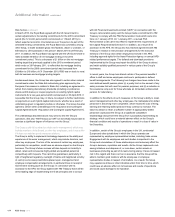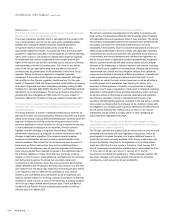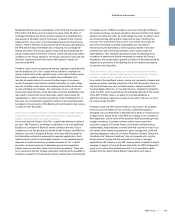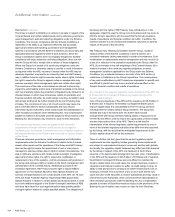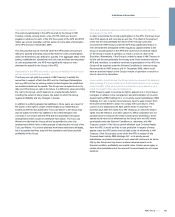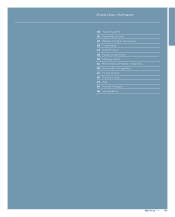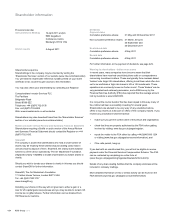RBS 2010 Annual Report Download - page 416
Download and view the complete annual report
Please find page 416 of the 2010 RBS annual report below. You can navigate through the pages in the report by either clicking on the pages listed below, or by using the keyword search tool below to find specific information within the annual report.Risk factors continued
In March 2010, the Royal Bank agreed with the UK Government to
certain adjustments to the lending commitments for the 2010 commitment
period (the 12 month period which commenced on 1 March 2010), to
reflect expected economic circumstances over the period. As part of the
amended lending commitments, the Royal Bank has committed, among
other things, to make available gross new facilities, drawn or undrawn, of
£50 billion to UK businesses in the period 1 March 2010 to 28 February
2011. In addition, the Royal Bank has agreed with the UK Government to
make available £8 billion of net mortgage lending in the 2010
commitment period. This is a decrease of £1 billion on the net mortgage
lending target that previously applied to the 2010 commitment period
which ends on 28 February 2011, to reflect that the mortgage lending
commitment for the 2009 commitment period was increased from
£9 billion to £10 billion. At 31 December 2010, RBS was on track to meet
both its business and mortgage lending targets.
As discussed above, the Group has also agreed to certain other material
commitments under the State Aid restructuring plan approved by the
European Commission in relation to State Aid, including an agreement to
refrain from making discretionary dividends (including on preference
shares and B shares) or coupon payments on existing hybrid capital
instruments for a two-year period which commenced on 30 April 2010. It
is possible that the Group may, in future, be subject to further restrictions
on payments on such hybrid capital instruments, whether as a result of
undertakings given to regulatory bodies or otherwise. The Group has also
agreed to certain other undertakings in the Acquisition and Contingent
Capital Agreement (the “Acquisition and Contingent Capital Agreement”).
The undertakings described above may serve to limit the Group’s
operations. See also “HM Treasury (or UKFI on its behalf) may be able to
exercise a significant degree of influence over the Group.”
The Group could fail to attract or retain senior management, which may
include members of the Board, or other key employees, and it may suffer
if it does not maintain good employee relations.
The Group’s ability to implement its strategy depends on the ability and
experience of its senior management, which may include directors, and
other key employees. The loss of the services of certain key employees,
particularly to competitors, could have an adverse impact on the Group’s
business. The Group’s future success will also depend on its ability to
attract, retain and remunerate highly skilled and qualified personnel
competitively with its peers. This cannot be guaranteed, particularly in
light of heightened regulatory oversight of banks and heightened scrutiny
of, and (in some cases) restrictions placed upon, management and
employee compensation arrangements, in particular those in receipt of
Government funding (such as the Group). In connection with its
accession to the APS, the Group agreed with HM Treasury that it will be
at the leading edge of implementing the G-20 principles and to consult
with UK Financial Investments Limited (“UKFI”) in connection with the
Group’s remuneration policy and the Group made a commitment to HM
Treasury to comply with the FSA Remuneration Code which came into
force on 1 January 2010. On 1 January 2011, a revised FSA
Remuneration Code came into effect to implement the requirements of
the Capital Requirements Directive III. In addition, as a result of its
accession to the APS, the Group also has reached agreement with HM
Treasury in relation to remuneration arrangements for the executive
directors of the Group and certain employees involved in the APS,
including approval rights for the Asset Protection Agency on annual APS-
related performance targets. The deferral and claw-back provisions
implemented by the Group may impair the ability of the Group to attract
and retain suitably qualified personnel in various parts of the Group’s
businesses.
In recent years, the Group has altered certain of the pension benefits it
offers to staff and some employees continue to participate in defined
benefit arrangements. The following two changes have been made to the
main defined benefit pension plans: (i) a yearly limit on the amount of any
salary increase that will count for pension purposes; and (ii) a reduction in
the severance lump sum for those who take an immediate undiscounted
pension for redundancy.
In addition to the effects of such measures on the Group’s ability to retain
senior management and other key employees, the marketplace for skilled
personnel is becoming more competitive, which means the cost of hiring,
training and retaining skilled personnel may continue to increase. The
failure to attract or retain a sufficient number of appropriately skilled
personnel could place the Group at a significant competitive
disadvantage and prevent the Group from successfully implementing its
strategy, which could have a material adverse effect on the Group’s
financial condition and results of operations or result in a loss of value in
the Securities.
In addition, certain of the Group’s employees in the UK, continental
Europe and other jurisdictions in which the Group operates are
represented by employee representative bodies, including trade unions.
Engagement with its employees and such bodies is important to the
Group and a breakdown of these relationships could adversely affect the
Group’s business, reputation and results. As the Group implements cost-
saving initiatives and disposes of, or runs-down, certain assets or
businesses (including as part of its restructuring plans), it faces increased
risk in this regard and there can be no assurance that the Group will be
able to maintain good relations with its employees or employee
representative bodies in respect of all matters. As a result, the Group
may experience strikes or other industrial action from time to time, which
could have an adverse effect on its business and results of operations
and could cause damage to its reputation.
RBS Group 2010414
Additional information continued












